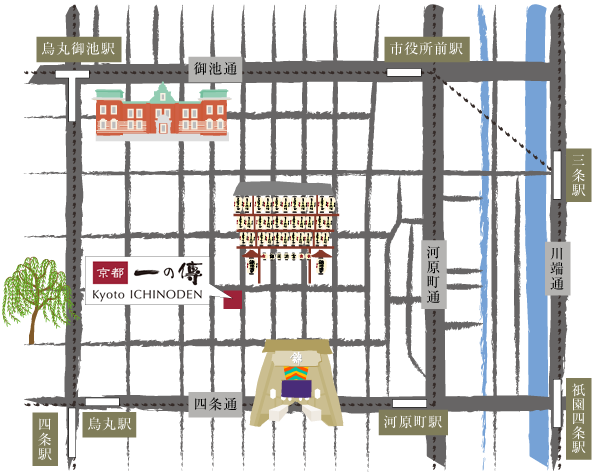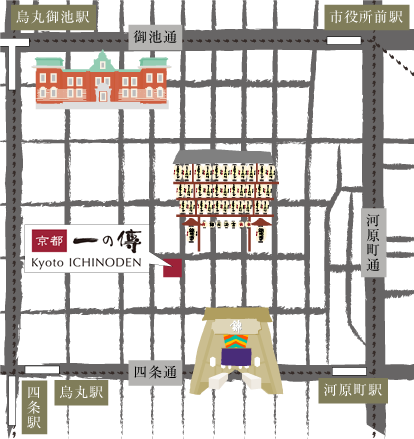SPECIAL CONTENTS
Rokkaku-do
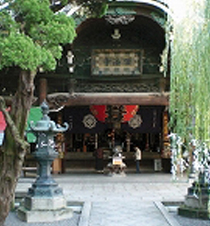
“Rokkaku-do (Official name : Shiunyama Choho-ji temple)” is a historic temple that is only 8 minutes walk to the northwest from the main store of Kyoto ICHINODEN. When Prince Shotoku came to this place in search of materials for the construction of Shitennoji, he had a revelatory dream telling him to build a hexagonal temple here. And it is said that Prince Shotoku placed the Buddharupa in the temple himself after the construction of the temple was completed. It is a temple that is also known as the birthplace of Ikebana (the Japanese art of flower arrangement).
Interesting Information
“The foundation stone in Rokkaku-do is located near the centre of Kyoto, hence it is also called the “”navel stone””. In the Heian period, it is said that the Rokkaku-do subtly moved and relocated on its own. But still, this incredible foundation stone always kept in the same position. “
How to get here
4 minutes walk from Kyoto Municipal Subway Karasuma Oike Station
(Around 8 minutes walk to the northwest from the main store of Kyoto ICHINODEN)
The Museum of Kyoto
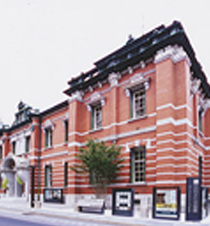
When you reach the northwest from Kyoto ICHINODEN Main Store, you will see a red brick building which is “The Museum of Kyoto”. The museum is divided into two parts: a main building which carries out various exhibitions throughout the year; and an annex building designated as an important cultural property. This old-fashioned machiya scenery shows a different taste of Kyoto.
Interesting Information
This musuem with a retro appearance was a famous architecture in the Meiji period. Originally it was used as the Kyoto Branch of Bank of Japan.
It was designed by Kingo Tatsuno, which is praised as the father of Japanese modern architecture and his pupil Uheiji Nagano.
How to get here
3 minutes walk from Kyoto Municipal Subway Karasuma Oike Station
(Around 8 minutes walk to the northwest from the main store of Kyoto ICHINODEN)
Yanagi no Banba-dori
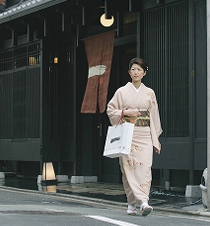
The street where Kyoto ICHINODEN Main Store is situated is “Yanagi no Banba-dori”. It runs through the famous “Kyoto’s kitchen” Nishiki Market. To the north you will find Maruta-machi-dori, where the Kyoto Imperial Palace is situated; and to the south you will find Gojo-dori. The street is around 2.3 km long in total. The history of this “Yanagi no Banba-dori” is very old, dating back to the Heian period. At that time it was called “Made no koji”, and the road was about 12 metres wide.
Interesting Information
During the time when Hideyoshi Toyotomi ruled, a row of beautiful willow trees was planted around the intersection with Nijo-dori. It is said that the origin of the name “Yanagi” comes from there.
How to get here
4 minutes walk from Kyoto Municipal Subway Karasuma Oike Station
(Around 8 minutes walk to the northwest from the main store of Kyoto ICHINODEN)
Teramachi-dori
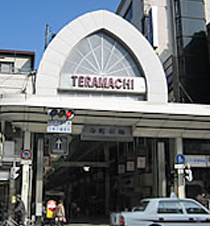
When going east from Kyoto ICHINODEN Main Store and through the arcade of Nishiki market, you will find “Teramachi-dori”. There are many shops selling Kyoto souvenirs. Many local students visit this area on a school trip. Today it is a shopping arcade where many new and old shops line up and is crowded with locals and tourists. But it is said that there were many temples in this area in the past, as its name suggests.
Interesting Information
This street has declined once in the past due to the Onin War. But it was restored and regenerated by Hideyoshi Toyotomi during the remodeling of Kyoto. It was named “Teramachi” and around 80 temples were forcibly moved to the east side of the street.
How to get here
4 minutes walk to the east from the main store of Kyoto ICHINODEN
Yata jizoson
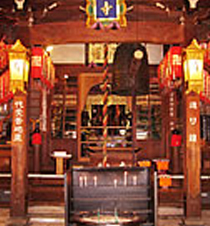
You can see “Yata jizoson” as you go north to Sanjo-dori through the busy Teramachi Arcade. Many lanterns with a warm colour are lit around the area, and a lot of Ksitigarbha statues are placed there, too.
The principal object of worship is a Ksitigarbha situated in the back of the precinct, standing in the fire. It is said that this Ksitigarbha, named Daijukujizo, saves people in hell. In addition, the “Farewell Bell” in the precinct is paired with the “Meeting Bell” in Daichinzan Rokudochinno Temple in Higashiyama, Kyoto. While “Meeting Bell” is to welcome ancestors to this side of the world, “Farewell Bell” is to send them to the world after death.
Interesting Information
At the shop inside the precinct, there are handmade “Ksitigarbha soft toy”. After prayer and dedication, you may buy one as a lucky charm or survenir.
How to get here
6 minutes walk from Kyoto Municipal Subway Tozai Line Kyoto Shiyakusho-mae Station
(Around 10 minutes walk to the northeast from the main store of Kyoto ICHINODEN)
Seiganji Temple
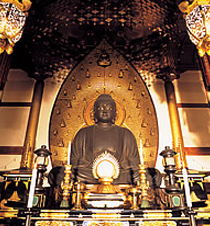
When you reach the northeast from Kyoto ICHINODEN Main Store, the headquarters of Jyodoshu (Jodo Buddhism or The Pure Land School) Seizan Fukakusaha “Seiganji Temple” is standing in front of the opening of the arcade.
“This place is also known as the stage for the Yokyoku* “”Seiganji Temple””. Since Izumi Shikibu was a bodhisattva of singing and dancing in the song, “”Seigan Temple”” is worshiped as a temple of mastering performance skills. Beside the main hall is a stone sculpture of Ogizuka, in which nowadays people would still dedicate fans in praying for improvement of their performance skills.
*Yokyoku (謡曲), also called utai (謡), is an integral part of the traditional Noh theatre in Japan. “
Interesting Information
Seiganji Temple is also known as the birthplace of Rakugo (a form of Japanese verbal entertainment). Many Rakugo fans visit the dedicated rakugo party held every October.
How to get here
Get off at Hankyu Train Kyoto Line Kawaramachi station, 6 minutes walk from the station
(Around 7 minutes walk to the southeast from the main store of Kyoto ICHINODEN)
Ryoma Sakamoto’s hiding place, the “Vinegar Shop”
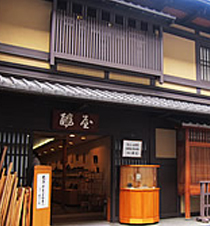
When you reach the northeast from Kyoto ICHINODEN Main Store, there is a timber trader “Vinegar Shop”, which is said to be Ryoma Sakamoto’s hiding place in the past.
Ryoma is said to have been living here until he was assassinated, under the auspices of the 6th generation of the Vinegar Shop, who showed an understanding of Ryoma’s activities.
Towards the end of Edo Period, it was said that before the “Vinegar Shop” was a cove in Takase-gawa River that provides a pier for boats. Residence of many Domains were along the river and it was a convenient place for communication. Ryoma set up the Kyoto headquarters of Kaientai (an association of roshi organized by Ryoma) here, where many volunteers including Mutsu Munemitsu were hanging out there.
Interesting Information
To date, the Vinegar Shop still runs as a timber trader. At the entrance of it stands a stone monument of Ryoma Sakamoto. The room Ryoma used to stayed on the second floor has turned into Ryoma Gallery, and it is open to the public where Ryoma’s remains can be found.
How to get here
Get off at Hankyu Railway Kyoto Line Kawaramachi station, 5 minutes walk from the station
(Around 9 minutes walk to the northeast from the main store of Kyoto ICHINODEN)
Seishin-in
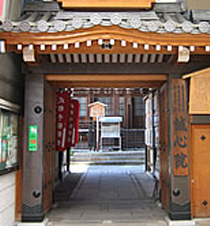
Walk from Kyoto ICHINODEN Main Store to Nishiki Market then go eastward and you will find the lively Shinkyogoku-dori. When you go north on this lively street bustling with young people and tourists, you will see “Seishin-in” on your right.
Izumi Shikibu is the first priest of “Seishin-in”. Empress Fujiwara Akiko asked his father Fujiwara no Michinaga to build this temple for Izumi as she entered the priesthood after her daughter’s death. The grave of Izumi Shikibu is quietly standing on the north side of the precinct. To date, there are still many people who admire Izumi visiting this place.
Interesting Information
When you go around the precinct, you will find a stone statue of “Mizukake ascetic” and a “Bell ring” which is said to be wisdom giving and love-giving. It is believed that they will give peace to the hearts of the worshipers.
How to get here
Get off at Hankyu Train Kyoto Line Kawaramachi station, 8 minutes walk from the station
(Around 8 minutes walk to the northeast from the main store of Kyoto ICHINODEN)
Nishiki Tenmangu
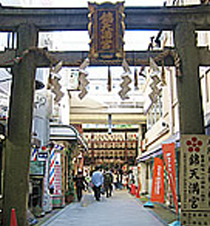
Enter the Nishiki Market from Kyoto ICHINODEN Main Store, then head east and you will see “Nishiki Tenmangu”. The locals call it “Nishiki no Tenshin” and pray for academic and business prosperity. The history of the “Nishiki no Tenshin” dates back to the middle of the Heian period. It was moved to the present place in Tensho 15th year (Year 1587) during the urban planning of Taiko, Hideyoshi Toyotomi. And from then on, it has come to be called “Nishiki Tenmangu”.
Interesting Information
The Otorii at the entrance is in a rare form as it is sandwiched between the buildings on both sides that were built afterwards. In addition, there are many special features to be found such as “Nishiki no mizu” which springs in the precinct and “Karakuri Mikuji” (mechanical fortune slip) that is rarely seen elsewhere in Japan.
How to get here
Get off at Hankyu Train Kyoto Line Kawaramachi station, 3 minutes walk from the station
(Around 8 minutes walk to the east from the main store of Kyoto ICHINODEN)
Nishiki Market
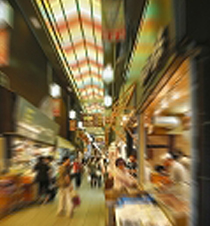
If you go south from the main store of Kyoto ICHINODEN, you will find the “Nishiki market”, which is known as the kitchen of Kyoto. Approximately 130 shops selling fruits, fresh fish, etc. line up along the road between Teramachi-dori in the east and Takakura-dori in the west (about 400m long in total), providing all sorts of groceries for Kyoto’s households.
Interesting Information
In addition to the many Kyoto-style ingredients you may find in the Nishiki Market, it is also a good place to buy souvenirs and enjoy all sorts of local food there and then.
Business hours vary from store to store, but the main business hours is from 10:00 to 18:00.
How to get here
3 minutes walk from Kyoto Municipal Subway Karasuma Oike Station
(Around 1 minute walk to the south from the main store of Kyoto ICHINODEN)
Gion Matsuri (Gion Festival)
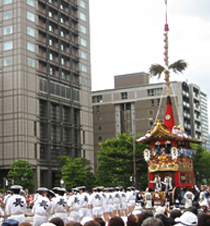
Speaking of Kyoto in July, you cannot miss the “Gion Matsuri (Gion Festival)”. This “Gion Festival” which is counted as one of the three biggest festivals in Japan together with the Tenjin Festival in Osaka and the Kanda Festival in Tokyo has a long history. In the Gion Festival, which lasts for up to a month, you can also see the highlight of the event, Yamahoko-Junko parade.
“Gion Festival” originated about 1100 years ago. At that time, an epidemic took place in the Kyoto area. In order to quell the epidemic, people started praising the Gozu Tenno (deity said to be the Indian god Gavagriva). And this traditional festival started from then on.
Interesting Information
The most well known event during the Gion Festival is the “Yamahoko-Junko parade” (takes place on 17th) . During the parade, 32 festival floats called “Yama” and “Hoko” will go around Kyoto City. Among the 32 floats, 29 of them have been designated as Important Tangible Folk Cultural Properties. It is a truly luxurious parade that cannot be found elsewhere.
How to get here
You can enjoy both “Yoiyama” and “Yamahoko-Junko parade” near the Kyoto ICHINODEN Main Store.
Hiyoke Tenmangu
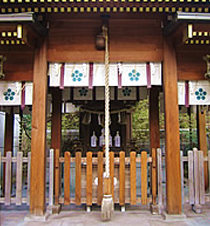
Walk from Kyoto ICHINODEN Main Store to Shijo-dori then go eastward. At the south of the junction of Shijo Teramachi where many department stores stand, you will find “Hiyoke Tenmangu”.
The occurrence of this “Hiyoke Tenmangu” is in the 7th year of Tensho (Year 1579). In order to escape the warfare of Tsukushi Province (Fukuoka prefecture), it is said that one old priest entered into Kyoto, carrying the statue of Sugawara no Michizane from Dazaifu, and started the worship activities around Rokkaku-dori. It was then transferred to the current place in the 2nd year of Keicho (Year 1597).
Interesting Information
It is said that during the Kinmon incident (禁門の変 Kinmon no Hen, “Forbidden Gate Incident” or “Imperial Palace Gate Incident”) in the first year of Genji (Year 1864), the entire city was surrounded by the flames of war. But only Hiyoke Tenmangu remained unburnt and undestroyed. In addition, there were also three battles during the Meiji period, but miraculously the area around the Hiyoke Tenmangu was not affected by the fire at all.
How to get here
Get off at Hankyu Train Kyoto Line Kawaramachi station, 5 minutes walk from the station
(Around 7 minutes walk to the southeast from the main store of Kyoto ICHINODEN)

